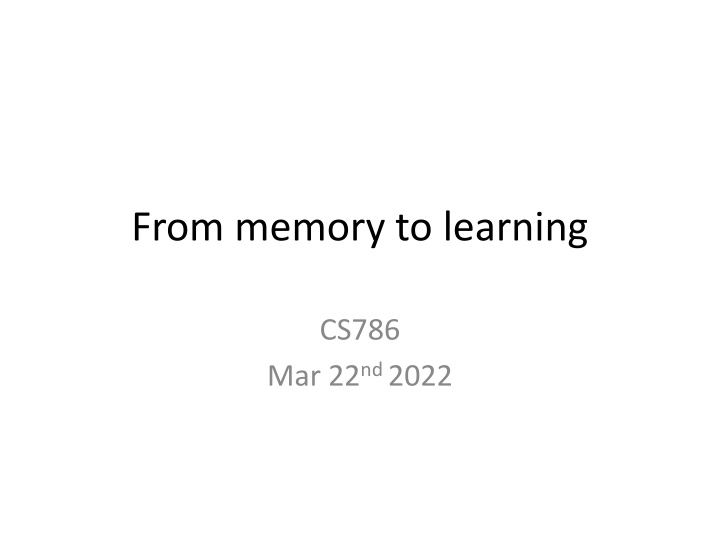
Explore Memory Encoding and Retrieval Models in Cognitive Science
Dive into the world of memory encoding and retrieval models like the Temporal Context Model (TCM) and Search of Associative Memory (SAM) in Cognitive Science. Understand how these models operate and their implications on memory processes and predictions. Explore concepts such as context drift assumption and semantic networks to enhance your understanding of human memory.
Download Presentation

Please find below an Image/Link to download the presentation.
The content on the website is provided AS IS for your information and personal use only. It may not be sold, licensed, or shared on other websites without obtaining consent from the author. If you encounter any issues during the download, it is possible that the publisher has removed the file from their server.
You are allowed to download the files provided on this website for personal or commercial use, subject to the condition that they are used lawfully. All files are the property of their respective owners.
The content on the website is provided AS IS for your information and personal use only. It may not be sold, licensed, or shared on other websites without obtaining consent from the author.
E N D
Presentation Transcript
From memory to learning CS786 Mar 22nd 2022
Temporal context model SAM makes no assumptions about the effect of the environment on retrieval cues guiding the memory process Accepted as inputs Recent retrievals can become cues for subsequent retrievals The temporal context model (TCM) changes this Assumes a linear drift of the temporal context cue that goes into every episodic memory encoding Recommended reading: (Howard & Kahana, 2002)
TCM encoding Items are represented as feature vectors f Context is also represented as feature vectors c on a different feature space Both item and feature vectors are time- indexed Construct an item-context mapping via an outer product
TCM retrieval Retrieval happens via spreading activation A state c on C will provide activation input fout= MFC c Similarity of this input to a given item f can be measured as a dot product This quantifies the retrieval pull the context exerts on each item Follows from f orthonormality (assumed)
The context drift assumption Assume a linear drift in context A little bit like a recurrent network Naturally makes contexts at closer times more similar than contexts at farther times from the probe point Yields long-term recency predictions
Search of associative memory In the last class, we saw the SAM model of memory encoding and retrieval If we can assume that we know the associative strength between all possible targets and cues We can predict various experimental outcomes in memory experiments But how do associative strengths get to be the way they are in your head?
Semantic Networks NORTHSOUTH EAST WEST HOSPITAL PATIENT NURSE DOCTOR LAWYER WEALTHY Explains everything and predicts nothing Hofstadter. Godel, Escher, Bach.
Can we be more precise in dealing with semantic networks? Griffiths and Steyvers made a great observation Search in the semantic network has the same information-theoretic constraints as relevance search on the internet Recommended reading: Griffiths, Steyvers & Firl. Google in the mind.
Basic idea Use PageRank to predict word completing task performance PageRank: Consider the adjacency matrix of all web pages L Important websites are linked to by other important websites Consider each link to be transporting some of each website s importance to the outbound connection Solve for importance; list websites containing search term in order of importance
Memory hypothesis All brain areas stimulated by a particular retrieval cue constitute nodes in a graph Consider the adjacency matrix of this graph, measure in terms of synaptic connectivity Consider accessibility of a memory engram as the equivalent of website importance We have a correspondence between web and memory search
Word completion task Given a letter, come up with as many words as you can that start with that letter
How to model this? PageRank-like associativity is the outcome What is the process? One possibility Activation spreads from node to node along associative links Assume each node spreads its activation equally over all nodes it is connected to New activation = old activation decay + inputs
Modeling formally Assume the vector x is activation for all nodes Here M is a matrix whose entries are L are binary outbound links in the graph
Semantic Networks Can say something about how the semantic network comes about Spreading activation from node to node brings the graph into its present shape Some predictions are possible Hofstadter. Godel, Escher, Bach.
Exploration in the semantic network Exploration of memory is affected by the familiar exploration-exploitation tradeoff But how? Search in memory is impossible? By manipulation of cues What sort of effect can environmental factors or previous tasks have on memory exploration? https://warwick.ac.uk/fac/sci/psych/people/thills/thills/2015hillstics.pdf
Thomas Hills memory search Optimal foraging theory Animal spends some time looking for food When it finds a patch of food, the rate of food acquisition drops over time Goal is to maximize rate of food accumulation Optimal theory predicts: shift to a new patch when food acquisition rate drops below global mean
A spatial foraging task Experimental task: find hidden areas of high reward Strategies differ
Same participants do a memory task Scrabble: find all words in the letter set NSBDOE
Word production shows sequential dependence
Previous task appears to control exploration propensity Semantic network traversal is cognitively controllable
